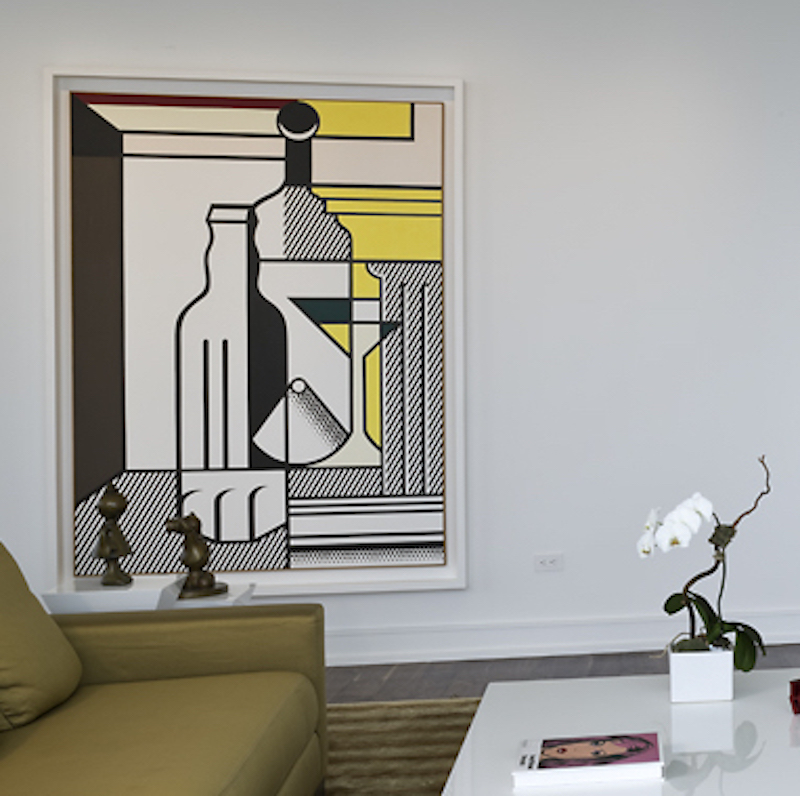Modern art seen through Roy Lichtenstein’s signature Ben Day aesthetic, Purist Painting with Bottles, 1975, is one of a handful of works by the artist that addresses the post-Cubist movement of Purism. A departure from the 1960s pop culture imagery which he had already conquered, in the 1970s Lichtenstein turned his focus to this art historical canon. Having first embarked on a series of Cubist inspired still-lives from 1973, by 1975 Lichtenstein’s practice found affinity with the radical approach and visual kinship to Purism and Purist Painting with Bottles stands as an adroit yet playful homage to early 20th century Modernism.

[Roy Lichtenstein, Purist Painting with Bottles, 1975, Oil and Magna on canvas, 74 x 54 inches] Provenance
Leo Castelli Gallery, New York.
Private Collection, Los Angeles (acquired from the above in 1975, and thence by descent).
Anon. sale, Christie’s London, 8 February 2007, lot 23.
Acquired at the above sale by the previous owner
Exhibition
New York, Leo Castelli Gallery, Roy Lichtenstein, 1975.
Los Angeles, Kantor Gallery, Whole Lotta Pop, 1995
–Roy Lichtenstein
“Purist Painting with Bottles depicts a decanter, a cocktail glass and a liquor bottle separated by bold lines that recall the geometries of Mondrian, or the divisions of a stained-glass window. Lichtenstein’s iconic Ben-Day dots add depth to the bottom quadrant that fills in the bottom of the decanter; the dots refract through the glass, which lead the eye up to flash of deep green. Elegant, striking and unmistakably Lichtenstein, Purist Painting with Bottles stands as an adroit and playful homage to the artist’s early twentieth-century forebears.
Led by Le Corbusier and Amédée Ozenfant, who set out their ideas in the 1918 book Après le Cubisme (After Cubism), the Purists rejected Cubism’s fragmentation of the object. They proposed a mode of painting that instead explored powerful, coherent basic forms, flattened and stripped back to essentials. Presenting everyday objects such as bottles and glasses in their still-life compositions, the Purists celebrated these items’ functional beauty by paring them down to arrangements of elemental shape. Joined by artists like Fernand Léger, they embraced technology and the machine, aiming to infuse mechanical and industrial subject matter with a timeless grandeur. Ozenfant’s still-life compositions even employed references to ancient Greek architecture, with bottles and glasses fluted like Classical columns – a motif echoed by Lichtenstein in the lower-right corner of Purist Painting with Bottles. Controversial at first, the Purist impulse towards perfect, flat images of the everyday gradually became absorbed into the discourse of Modernism, and would later find a rhyme in the slick consumer goods advertisements that so fascinated Lichtenstein as a Pop artist. In his ‘Purist’ pictures, Lichtenstein investigates the overlap between the Purists’ interest in the ubiquitous, artificial and mechanical and his own Pop engagement with the same themes. Exploring the mutual ambitions of both movements, he employs his signature reductive visual strategies – most notably the Ben-Day dot, which refers directly to the processes of commercial printing – to disrupt high art with the vocabulary of the tabloid, the billboard and the magazine.
In condensing the glass and carafe of Purist Painting with Bottles to potent, fundamental form – they become archetypal, iconic objects like the hotdogs or brushstrokes of his earlier works – Lichtenstein reproduces the Purist aesthetic, but he also hijacks the powerful visual shorthand of cartoon and advertisement. The two modes of representation are hybridized to create a work of undeniable but disorienting impact. The flatly descriptive title Purist Painting with Bottles serves to heighten the sense of decontextualization: could a true ‘Purist Painting’ possibly be made half a century after the movement’s demise? By the 1970s, it was clear that the Purists’ optimistic attitude towards technology and future had hardly led to an ideal society; instead, this work implies, their idealizing aesthetic was absorbed and repurposed by the graphic language of mass culture to help sell the very things the Purists had celebrated – before finding its way back into art through Lichtenstein’s Ben-Day conceptual lens. Lichtenstein superimposes and blurs these levels of transformation into a painting that is visually flat but conceptually many-layered, raising complex questions not only about the attitudes contained within works of art but also about the wider societal and cultural ideals that they enshrine.
The visual interests that Lichtenstein shared with Purism lend Purist Painting with Bottles an internal cohesion and logic stronger than in many of his takes on other art movements. Insisting on a non-painterly mode of painting that redacts evidence of the artist’s hand with strict lines, flat, uniform colors and regular Ben-Day dots, Lichtenstein amplifies some of Purism’s own traits; he revives and reframes it as a way of reflecting on a world defined by the mass-media that swallowed it up. Lichtenstein etches his own instantly recognizable approach into the canon of art history with a blend of satire and reverence, restating the art of the past in his own terms. ‘All painters take a personal attitude toward painting’, he said. ‘What makes each object in the work is that it is organized by that artist’s vision. The style and the content are also different from anyone else’s. They are unified by the point of view – mine. This is the big tradition of art’ (R. Lichtenstein, quoted in C. Tompkins, Mural with Blue Brushstroke, New York, 1987, p. 42)
